
16 minute read
Regular manoeuvres and emergency departures
In the sixties the Dutch aircraft carrier Karel Doorman called at the Port of Fremantle, which required a manoeuvre to swing it in the port with the help of tugs. However, there was a problem – the tugs were on strike. The aircraft were secured on the flight deck, and the ship was turned and brought into berth using the aircraft engines as ‘thrusters’. This is of course not an option for most vessels expecting tugs and finding that none are available, whether due to breakdown, emergency, political conflict or any other cause, but other options may be viable, depending on the situation and the experience and confidence of the Master.
In all these cases experienced pilots are needed, although in the case of a true emergency it may be necessary to depart without one.
Although there are no strict limitations with respect to ship size, from a practical point of view this article regards a ship length of about 225m as a maximum, unless otherwise mentioned. The practicality of the manoeuvre will of course depend on port lay-out and environmental conditions – 225m may be considered a very large ship in some ports, and a relatively small one in others.
Warning
As ports differ, so will differ the quay construction and fendering. Even in the same port, the manoeuvres below might be possible at one quay or terminal but not at another, due to the quay construction or fendering which may damage the ship. Cranes that might hinder the manoeuvres should be removed in time.
Furthermore, full manoeuvrability should be available which means no limitations on engine or bow/stern thruster use. Nowadays, with the increase in automation on engine performance, more than half of ships have limitations on engine use, even in harbour manoeuvring range. This is a serious and increasing problem.
minimal. Other wind directions may support the manoeuvre. It is therefore important to have a good look at the wind and the consequences.
If larger tugs are unavailable – for example, due to breakdown –ships loaded with bulk cargo can successfully be handled using less powerful tugs than would usually be the case. It just takes somewhat longer. This can be expressed by the formula:
F = m x a where ‘F’ is the tug force, ‘m’ the mass of the vessel and ‘a’ the acceleration. The smaller the tug force, the smaller the acceleration/ deceleration, e.g. for a course correction or speed reduction. Ships affected by wind should only be handled when wind force is below the total available tug force.
Considerations Where No Tugs Are Available
Sometimes, there may be no tugs available at all due to breakdown or strike. Larger ships equipped with a bow thruster but which usually use tugs may still be able to arrive and depart using the methods discussed below.
From a port management point of view, it is recommended to take appropriate measures so that any possible difficulties for arriving and departing ships are cleared. Arrival or departure of any vessel that usually uses tugs should be discussed between the Master, the pilot in charge and the harbour authorities to determine what manoeuvres are possible under what conditions.
Points for consideration include, but are not limited to:
1. Port traffic control to be informed.
2. Favourable wind and current.
3. Good visibility.
4. Day and/or night navigating.
Wind force and direction are crucial factors in all of these situations. Most problematic are onshore winds. In case of ships sensitive to wind, onshore wind velocity should be zero or
5. Proper planning of other traffic.
6. No obstruction by dredging material, sounding boats, etc.
7. Use of ship’s anchor allowed.

8. Berth free over sufficient length.
9. Berth free from cranes.
10. Container cranes topped.
11. Availability of mooring men and mooring boats.
12. Condition of mooring arrangements, bitts, bollards and mooring lines.
In many cases, the anchor – the ‘poor man’s tug’ – can be of great help for turning, mooring or unmooring without side thrusters, even for rather large ships. Often just one shackle is sufficient for turning or mooring; effectively working with a dragging anchor. For example, at the former Suralco aluminium factory on the Suriname River, bulk carriers of around 200m LOA swung around on the anchor in the relatively small river and moored without tug assistance port side alongside the jetty.
ARRIVAL: BACKWARDS INTO HARBOUR BASIN
Ships with good working bow thrusters (see opposite), such as many container ships, can easily manoeuvre head first into a harbour basin. However, manoeuvring backwards, as shown in figure 1, below, has several advantages. With a speed of about 4 knots the ship manoeuvres backwards to the berth, steered by the bow thruster.
When coming close to the berth the engine is set on ahead with the rudder hard to port and with the bow thruster to starboard. The ship can now be manoeuvred alongside in such a way that it comes parallel alongside with a low approach speed.
Some key questions we might ask include:
• Why does the same thruster work better on one ship than on another?
• Why does a bow thruster lose its effectiveness so quickly with increasing forward speed?
• Why does a bow thruster perform so much better when the ship has speed astern?
• What about a stern thruster?
Design And Installation
When designing and installing a side thruster, ideally:
• The upper part of the bow thruster tunnel should be at least 0.5 – 1 times the diameter of the bow thruster under water;

• Distance from lowest part of the tunnel to the keel should be at least the diameter of the bow thruster;
• The ship’s sides near the entrance of the tunnel must be as close as possible to parallel both vertically and longitudinally – preferably not a V-shape;
• The tunnel length should be 2 – 3 times its diameter; more if the tunnel is V-shaped;
• The propeller should be in the middle of the tunnel – otherwise it will work noticeably better to one side than to the other side;
• The entrance/exit of the tunnel must be well rounded or chamfered to prevent vortices, which can cause a considerable loss in effectiveness;
• Many tunnels have ‘shell’ shaped openings with larger chamfering aft of the tunnel to reduce sailing resistance. This will guide the water flow properly into the tunnel when the vessel is moving astern.
• Any protective grilles in front of the tunnel entrance/exit must be constructed to reduce the resistance of the tunnel entrance when the ship is moving, but disturb the inflow of water as little as possible when the bow thruster is used;
• Stern thrusters have generally less power than the bow thruster. If these requirements are not met, a bow thruster may perform less effectively than a bow thruster of the same power on ships that meet the requirements.
Ship Moving Ahead
A Brief Guide To Thrusters
Side thrusters can considerably improve ship handling – but it is essential that they are set up and used correctly.
There are various types of thrusters on the market. Those found on merchant ships may be electric, hydraulic or diesel driven built-in thrusters with fixed or variable propellers. Most common are electrically driven bow thrusters with Controllable Pitch Propellers (CPP).
A bow thruster loses much of its effectiveness as the ship gathers headway. In general, thruster effectiveness decreases by about 50% at 2 knots, with only minimal performance at 5 knots.
Figure 1A shows a ship with headway, with the bow thruster set to starboard. The bow thruster creates water flow in and out of the thruster tunnel. The figure shows the resulting areas of low and high pressure.
Bernoulli’s Law states that an increase in water speed results in a decrease in water pressure and vice versa. The accelerated water flow out of the thruster creates a low pressure field along the port hull forward. While the bow thruster is trying to move the bow to starboard, this low pressure works in the opposite direction, counteracting the bow thruster.
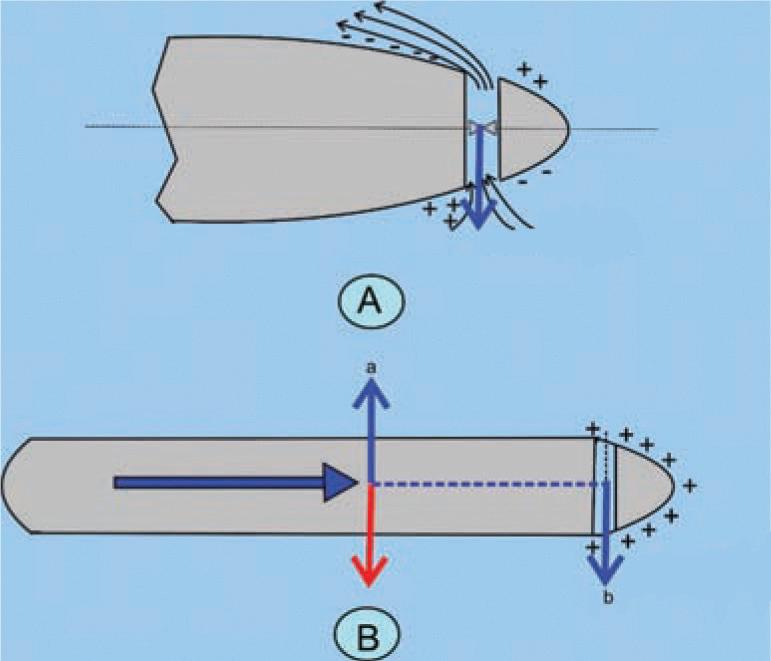
The greater the ship’s speed, the more closely the outward water flow will follow the ship’s hull. At a certain (relatively high) speed the flow may run along the length of the hull, creating a low pressure field over the whole ship’s length. This will not counteract the bow thruster.
The distribution of the low pressure field over the ship side will affect the turning performance of the bow thruster depending on the speed, draft, trim and UKC. At high speed it may even contribute to the turning performance of the bow thruster.
Some ships have an Anti Suction Tunnel (AST) behind the bow thruster or between two bow thrusters. This tunnel connects the pressure fields at both sides of the tunnel, reducing the difference in pressure and further reducing the negative effect of the large low pressure field on the bow thruster’s effectiveness.
The sideways force tries to move the ship to starboard. This is counteracted by the hydrodynamic force centred forward (see the +marks), which will try to turn the ship to port. This hydrodynamic force increases with ship speed.

The result is that when the bow thruster of a ship having headway is set to starboard, at the same time:
• A negative pressure field develops that counteracts the working of the bow thruster.
• The hydrodynamic force centred at the bow counteracts the working of the bow thruster.
Both effects increase with ship speed. Consequently effect of the bow thruster decreases quickly with increasing ship speed.
Ship Moving Astern
When moving astern, a bow thruster works perfectly!
Looking again at figure 1A, when the bow thruster is set to move the bow, but the ship is sailing astern, the low pressure field created by the flow out of the tunnel will not be directed along the ship’s hull. Consequently, it will not affect the performance of the bow thruster.
Another important effect of sailing astern is that the water near the hull is dragged along by hull friction and is therefore more easily sucked into the tunnel opening, even at higher speeds.
The hydrodynamic force working sideways on the ship (red arrow; figure 1B) has moved to the ship’s stern and will tend, in this case, to turn the ship to starboard, contributing to the working of the bow thruster.
Stern Thruster
The stern thruster usually has less power than the bow thruster.
When initiating a turn, there is another counter acting effect which also causes bow thruster performance to decrease with increasing speed ahead – as shown in figure 1B.
The bow thruster is set to starboard. It generates force b. This force b creates a turning moment a-b, together with a sideways force (see red arrow). The turning moment a-b tries to turn the ship to starboard.
All of the theory above applies to a stern thruster as well – but the location of the stern thruster makes it more difficult to comply with the construction requirements. Further, the stern thruster may lose effectiveness when giving astern on the engine due to the wake of the ship’s propeller.
All these factors mean that effectiveness of a stern thruster will be low.
The advantage of this manoeuvre is that the ship can be steered easily by the bow thruster and can be stopped immediately by the engine; the engine can also be used on ahead, if necessary, in combination with the rudder to direct the stern in the required direction.
On a very few ships with a controllable pitch propeller it can be difficult to stop when having sternway. If this is known to be an issue, it can be anticipated by giving ahead at an early stage.
This approach manoeuvre can be carried out given favourable winds and no currents.
CASE STUDY: STRONG WINDS

In case of strong onshore winds a large steering angle may be needed to counter drift. Figure 2, below, shows a feeder ship of about 120m length with containers stacked three high on deck. The main engine is 8000 HP (6000 kW) and bow thruster 500 HP (appr. 380 kW). There is a crosswind of about Beaufort 6.
The ship is manoeuvring backwards into a harbour basin with the engine on slow astern, about 1000 HP (745 kW). Transverse effect of a right handed fixed pitch propeller can be about 10%, which is 1 ton.
To steer a compensating drift angle the bow thruster is set half to port, which is 2 – 3 tons force. We now have a force of 1 + 2.5 = 3.5 tons working crosswise on the ship towards the shore. Taking into account a cross wind of 6 Beaufort (12m/sec), this will give an additional force of about 15 tons. In total, 18.5 tons are working to the shore side. This requires a large steering angle. At a certain wind force – depending on size, power and windage of the vessel – the necessary drift angle may be so large that the manoeuvre is not viable.
All lines except the forward spring are released. The bow thruster is set away from the quay – in this case to starboard – and the engine on Dead Slow Ahead with port rudder. If well regulated, the ship comes square of the berth. Once the vessel is parallel, and far enough from the berth, the engine can be stopped, the back spring released and the bow thruster kept running to starboard. The ship will then pivot around the red dot at the stern of the ship.
Once the bow is far enough round to pass the ship in front, the ship can depart.
This manoeuvre needs a good spring, with some flexibility to avoid peak loads, and a calm starting engine on Dead Slow Ahead.
DEPARTURE – LARGE SHIPS WITH BOW THRUSTER
At first glance, it might seem that working with the pivot point offers a nice method to depart from the berth without the use of tugs – see figure 4, below. However, be aware that this method does not work when departing from solid quays.

Situation 1
Departure On Forward Spring Plus Bow Thruster
Figure 3 shows a method to depart from the berth with the use of a forward spring. This method might be necessary for smaller ships when moored behind a large ship, for example.

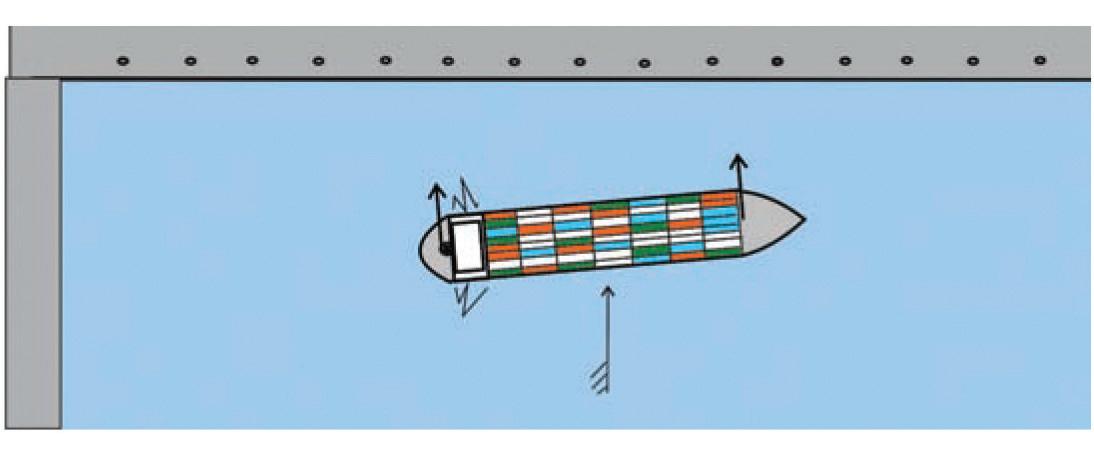
Situation 2
Situation 3
In situations where this is viable, all lines are released except for the forward spring. The bow is moved towards the quay (in this case to starboard) by the bow thruster. The pivot point is the ship shoulder resting on the quay – the red dot forward. When the bow is turned far enough to starboard, the forward spring can be released, and the bow thruster is set to port. The ship will then pivot around the point indicated by the red dot at the stern of the ship. When the bow has been turned far enough, the ship can depart.
The most likely reason that this does not work when departing from solid quays is that as the bow moves away from the quay, water will flow along the ship’s hull, filling the gap created by the bow moving away. This water flow creates a low pressure zone, with the consequence that the ship’s hull is pushed towards the quay again.
What does work in this situation is to give slow astern on the engine and the bow thruster full to port once the ship is in position 2.
Due to the transverse effect of the propeller and the bow thruster, the ship will turn to port and move away from the quay. When speed astern is 1 – 2 kt, the engine can be set on ahead with the bow thruster running to port as long as needed. The ship can so depart. If for some reason the stern comes too close to the quay, starboard rudder can be given. Bear in mind that this manoeuvre can only be carried out safely if a ship with right handed propeller is moored starboard side to.
The departure manoeuvre shown in figure 4 can also be used when a container ship has to back out of the harbour basin – figure 5, below. Again, this manoeuvre can only be carried out safely if a ship with right handed propeller is moored starboard side to. When the bow has been pushed far enough in, the spring line can be released, and the engine be set astern. Due to the right handed propeller the ship may turn to starboard. Use the bow thruster to compensate if necessary.
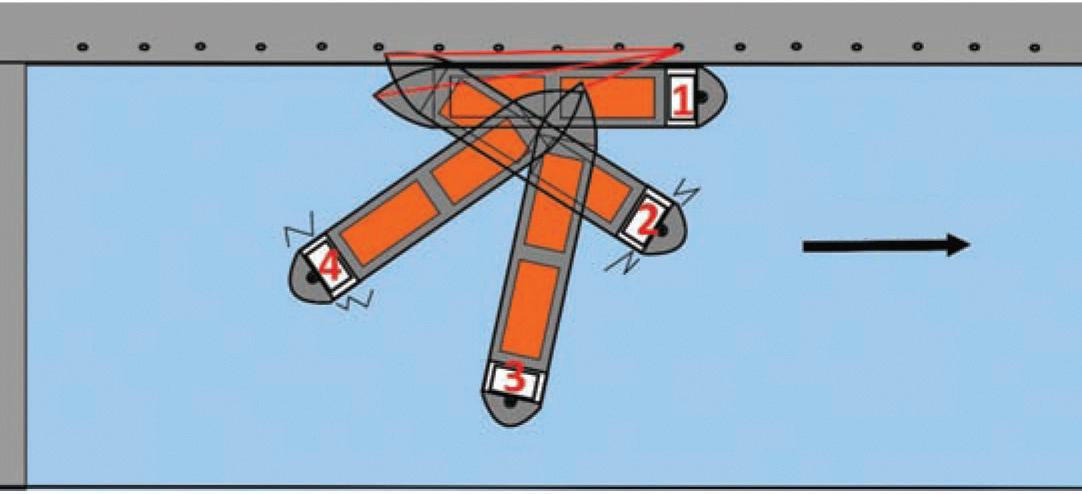

In many ports ships are manoeuvred backwards into a harbour basin or to a jetty. A good policy; in case of emergency, and where circumstances allow, ships can easily depart if necessary. For ships moored at a river quay or jetty, current will play a large role in whether or when a ship can depart without tugs. Emergency departure may also be complicated where bridge and lock openings must be arranged.
Matters are more problematic where ships are moored head-in. Ships equipped with a bow thruster may consider the possibilities outlined above. For ships without a bow thruster, the following manoeuvres may be helpful.

Linesmen will probably not be available in case of emergency departure. The last line(s) should be taken double (with a bight) so that they can be released from the ship’s deck.
For Smaller Ships
A small ship, say up to 80 metres length, laying head-in in a harbour basin, as shown in figure 6, below, might depart by setting a long spring.
Emergency Departures
In some ports a tsunami warning may force ships to depart without tug assistance. Other reasons for an emergency departure may include fire or an explosion in the harbour – or even suddenly arising political conflicts.
All other lines except the spring are released, and the stern is pushed off by engine and rudder. Once at an appropriate angle with the quay (position 2), the ship can be given a bit of sternway to keep the bow free from the quay while at the same time heaving on the spring line.
When the ship has reached position 3, heaving can be stopped. The tight spring might give an extra swing due to the backwards movement and should then quickly be released (position 4). The ship will keep swinging a bit, and with the use of engine and rudder the ship can leave the harbour basin.
Larger Vessels
Now four situations will be discussed for larger ships.
It will be assumed that the ships have a right handed propeller and no bow thruster. Ships with a controllable pitch propeller are not considered, as the behaviour of such ships when giving astern thrust is unpredictable.
Wind conditions should be carefully considered before departure. Depending on the draft and windage, any onshore wind may make a safe departure risky.

HEAD IN, STARBOARD SIDE ALONGSIDE
The ship can depart as shown in figure 7, top right. All stern lines are released. The forward spring is kept fastened. The head lines are released except for one line, from the centre lead or from port. With this line, the bow is heaved towards the shore and the stern will swing away from the quay. With a prudent dead slow ahead on the engine and hard starboard rudder (2) the stern can be moved somewhat faster and further away from the shore. It is best to use a double spring, both at equal tension and preferably on the same bollard at the quay.
HEAD IN, PORT SIDE ALONGSIDE
Here, the situation becomes problematic.
When the stern is far enough off, all forward lines can be released and the engine set for slow astern with hard port rudder. The ship will start to swing further to starboard (position 3), mainly due to the right-handed propeller. Once far enough from the quay, the ship can be turned further to starboard by alternatively using ahead on the engine (eg Slow Ahead) and hard starboard rudder, and astern on the engine (eg Slow or Half Astern) with hard port rudder. When turned far enough the vessel can depart. This manoeuvre can, of course, only be done at terminals where sufficient manoeuvring room is available.
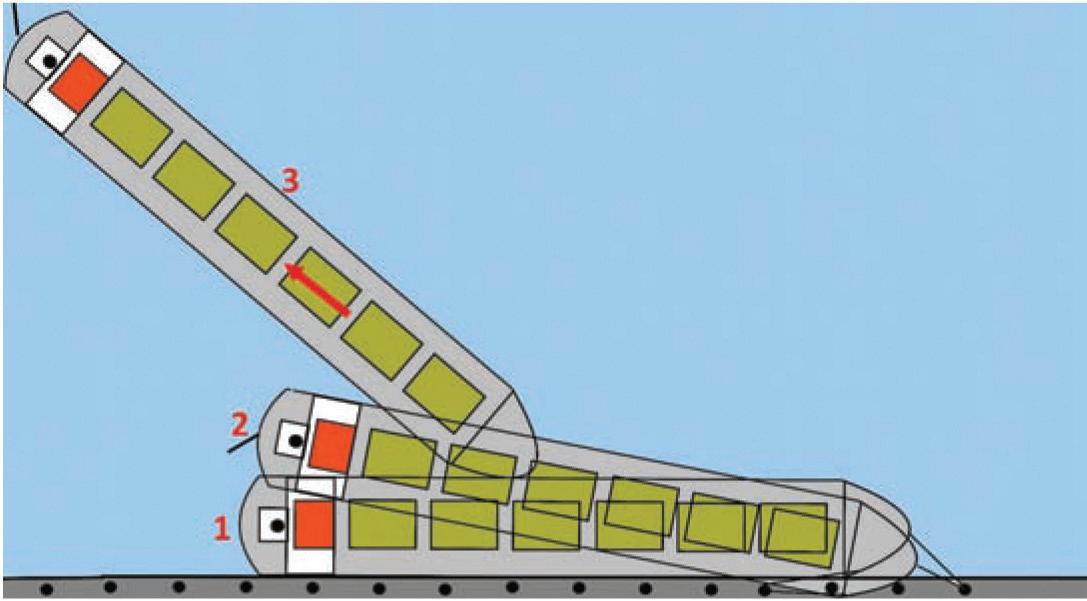
Again, the bow is heaved towards the quay, with the rudder hard to port and, if necessary, engine on dead slow. See figure 8, above.
When the stern is far enough out the engine can be set on dead slow astern. Watch the stern carefully, because the transverse effect of the propeller will pull the stern towards the quay. Once the ship is turned far enough to starboard and away from the quay, the engine can be set on ahead, again taking care that the stern is kept free from the quay. The ship should then sail to a location where there is room enough to turn.
Note: this manouevre is only suitable if:
• No vessels are moored behind the ship.
• The ship can access a location when there is room enough to turn once it has left the quay. If no such location is available, departure without tugs is too risky.
STERN IN, PORT SIDE ALONGSIDE
Heave the stern in with a stern line while keeping the stern spring fastened and releasing the forward lines. A careful dead slow astern may help. The spring can then be released without the help of linesmen.
If moored stern in with port side alongside the method shown in figure 8 could also be used with care if no ship is moored behind.

STERN IN, STARBOARD SIDE ALONGSIDEE
Similarly to the previous manoeuvre: The spring to be taken double again as a bight with the eye on board. Release the forward lines and stern lines except for a line from the centre lead aft and the aft spring. Heave the stern in with the stern line from the centre lead. A careful dead slow astern may help. The spring can then be released from the ship without the help of linesmen.
Risk Management
Manoeuvring without tugs involves additional risks. Safety margins are smaller and more time and careful planning is needed. This includes the need to investigate beforehand whether bringing the bow or stern towards the quay can be done without causing damage to quay and/or ship.
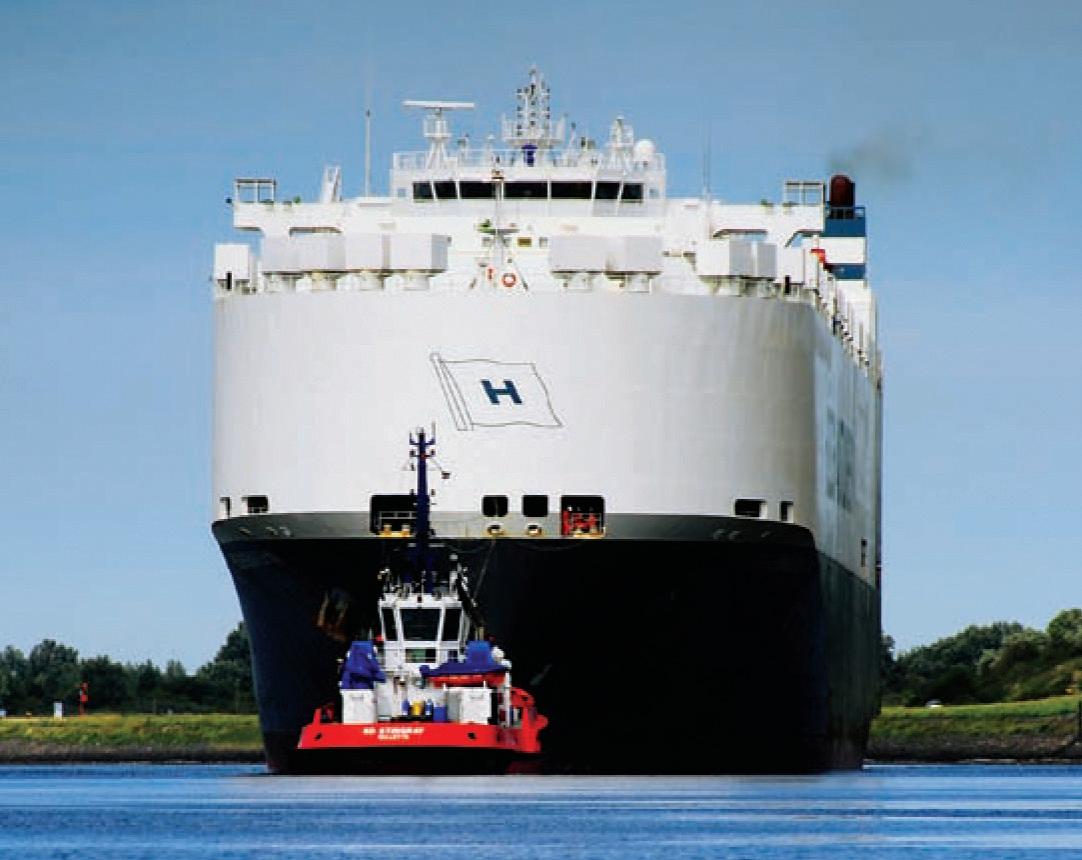
Particularly for emergency manoeuvres, it would be a good idea for a port to test emergency departure manoeuvres for critical berths during various wind speeds and directions and ship drafts in a simulator with the involvement of local pilots.
Both port and ship should always have a port contingency plan in place, and both Masters and pilots should be prepared for the eventuality of an emergency departure.
While it is still possible for much of the traffic to come and go from a port even where the usual tugs are not available, the possibilities discussed above depend to a large part on the experience of the pilots. The use of tugs is not an unnecessary luxury. As soon as they become available, they should be used again.
Tugs are not a luxury
FURTHER READING:
Emergency Unberthing without Tug Assistance. Kunieda, H. Yabuki, T. Okazaki. Tokyo University of Marine Science and Technology, Tokyo, Japan. TransNav Volume 9, Number 5, September 2015.
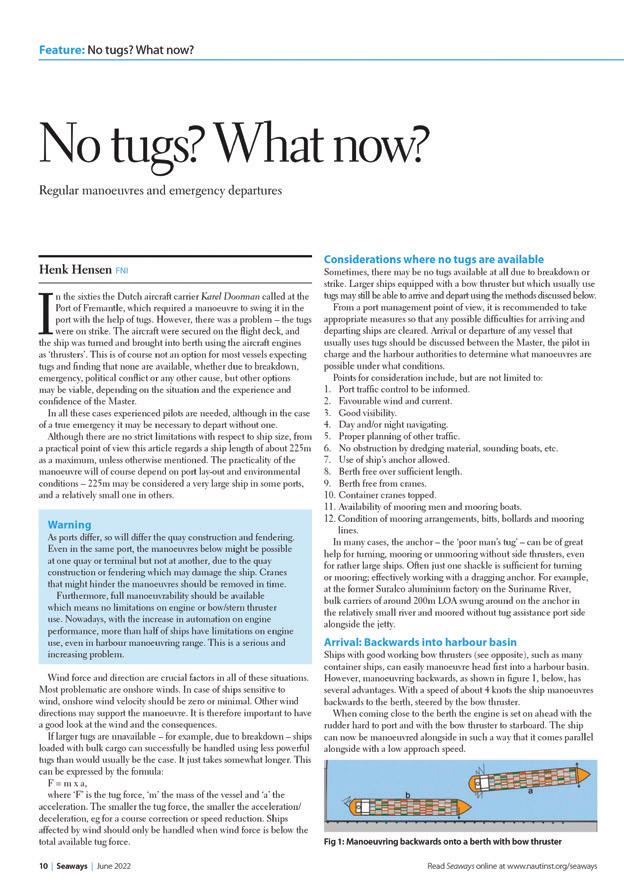
Tug Use in Port. 4th edition. STC Publishing, The Netherlands. 2021..
www.nautinst.org








